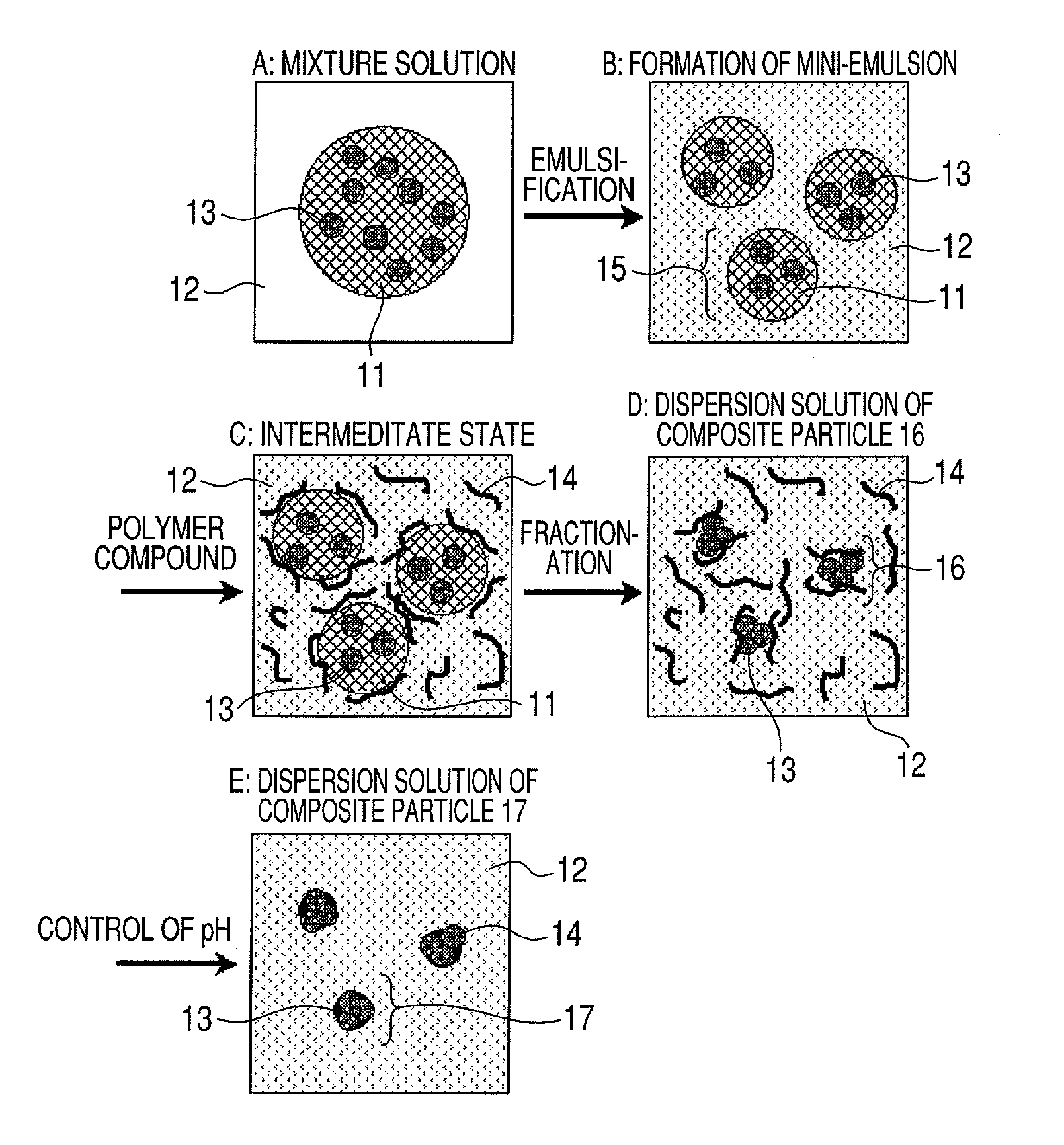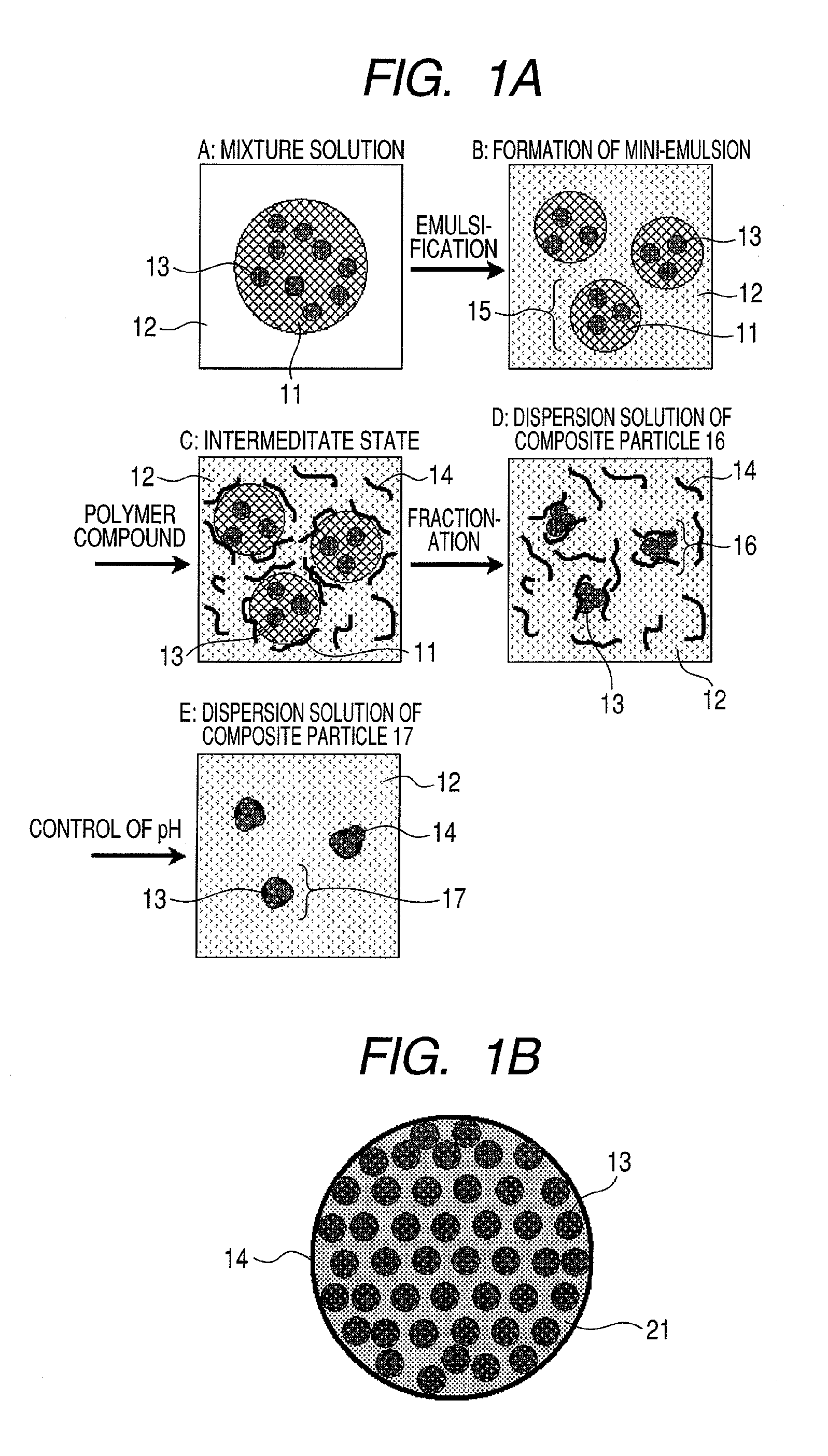Composite particle, method for producing the same, dispersion solution, magnetic biosensing apparatus and magnetic biosensing method
a biosensor and composite particle technology, applied in the field of composite particles, can solve the problems of increasing noise of non-target substances, difficulty in producing magnetic particles satisfying all characteristics, and insufficient saturation magnetization per magnetic substance, etc., to achieve high saturation magnetization, excellent monodispersibility, and high magnetic-substance content per particle
- Summary
- Abstract
- Description
- Claims
- Application Information
AI Technical Summary
Benefits of technology
Problems solved by technology
Method used
Image
Examples
example 1
[0261]Hydrophobic magnetite (3.0 g) having a Dw of 8 nm was dispersed in hexane (6 g) to prepare a hexane mixed solution. Subsequently, sodium dodecyl sulfate (SDS) (0.01 g) was dissolved in distilled water (30 g) to prepare an SDS aqueous solution. Furthermore, Polymer compound 1 (1 g) was dissolved in distilled water (50 g) controlled to pH 11 with sodium hydroxide to prepare an aqueous polymer compound solution.
[0262]The hexane mixed solution and the SDS aqueous solution were mixed to obtain a solution mixture. While the solution mixture was cooled by a cooling agent, the mixture was sheared by an ultrasonic homogenizer for 4 minutes to prepare an emulsion. The obtained emulsion was evaluated by DLS 8000. As a result, Dhw was 230 nm, Dhn was 211 nm and Dhw / Dhn was 1.09. It was confirmed that the emulsion is classified into a mini-emulsion.
[0263]To the obtained mini-emulsion, the aqueous polymer compound solution was added and stirred at room temperature for 30 minutes. Thereafter...
example 2
[0266]Hydrophobic magnetite (3.0 g) having a Dw of 8 nm was dispersed in hexane (6 g) to prepare a hexane mixed solution. Subsequently, SDS (0.01 g) was dissolved in distilled water (30 g) to prepare an SDS aqueous solution. Furthermore, Polymer compound 2 (1 g) was dissolved in distilled water (50 g) controlled to pH 1.5 with an aqueous hydrochloric acid solution to prepare an aqueous polymer compound solution.
[0267]The hexane mixed solution and the SDS aqueous solution were mixed to obtain a solution mixture. While the solution mixture was cooled by a cooling agent, the mixture was sheared by an ultrasonic homogenizer for 4 minutes to prepare an emulsion. The obtained mini-emulsion was evaluated by DLS 8000. As a result, Dhw was 217 nm, Dhn was 197 nm and Dhw / Dhn was 1.10. It was confirmed that the emulsion is classified into a mini-emulsion.
[0268]To the obtained mini-emulsion, the aqueous polymer compound solution was added, and stirred at room temperature for 30 minutes. Thereaf...
example 3
[0271]Experiment was performed under the same conditions as in Example 1 except that hydrophobic magnetite having a Dw of 12 nm was used. Also in this case, it was confirmed that an emulsion that can be classified into a mini-emulsion can be obtained.
[0272]The obtained Composite particle 3 was evaluated by TEM. As a result, Dw was 181 nm, Dn was 163 nm and Dw / Dn was 1.11. Since a coating layer of Polymer compound 1 on the surface of Composite particle 3 was not clearly confirmed in the image of TEM, it is presumed that Polymer compound 1 is not present on the surface of Composite particle 3 or forms an extremely thin film. Furthermore, evaluation was performed by TG-DTA (Thermogravimetry / Differential Thermal Analysis). As a result, the magnetite content of Composite particle 3 was 85 wt %.
[0273]The dispersion solution of Composite particle 3 was evaluated by DLS 8000. As a result, a single-peak particle size distribution was obtained. Dhw was 184 nm, Dhn was 166 nm and Dhw / Dhn was 1...
PUM
| Property | Measurement | Unit |
|---|---|---|
| weight-average dry particle size | aaaaa | aaaaa |
| particle size | aaaaa | aaaaa |
| weight-average dry particle size | aaaaa | aaaaa |
Abstract
Description
Claims
Application Information
 Login to View More
Login to View More - R&D
- Intellectual Property
- Life Sciences
- Materials
- Tech Scout
- Unparalleled Data Quality
- Higher Quality Content
- 60% Fewer Hallucinations
Browse by: Latest US Patents, China's latest patents, Technical Efficacy Thesaurus, Application Domain, Technology Topic, Popular Technical Reports.
© 2025 PatSnap. All rights reserved.Legal|Privacy policy|Modern Slavery Act Transparency Statement|Sitemap|About US| Contact US: help@patsnap.com



